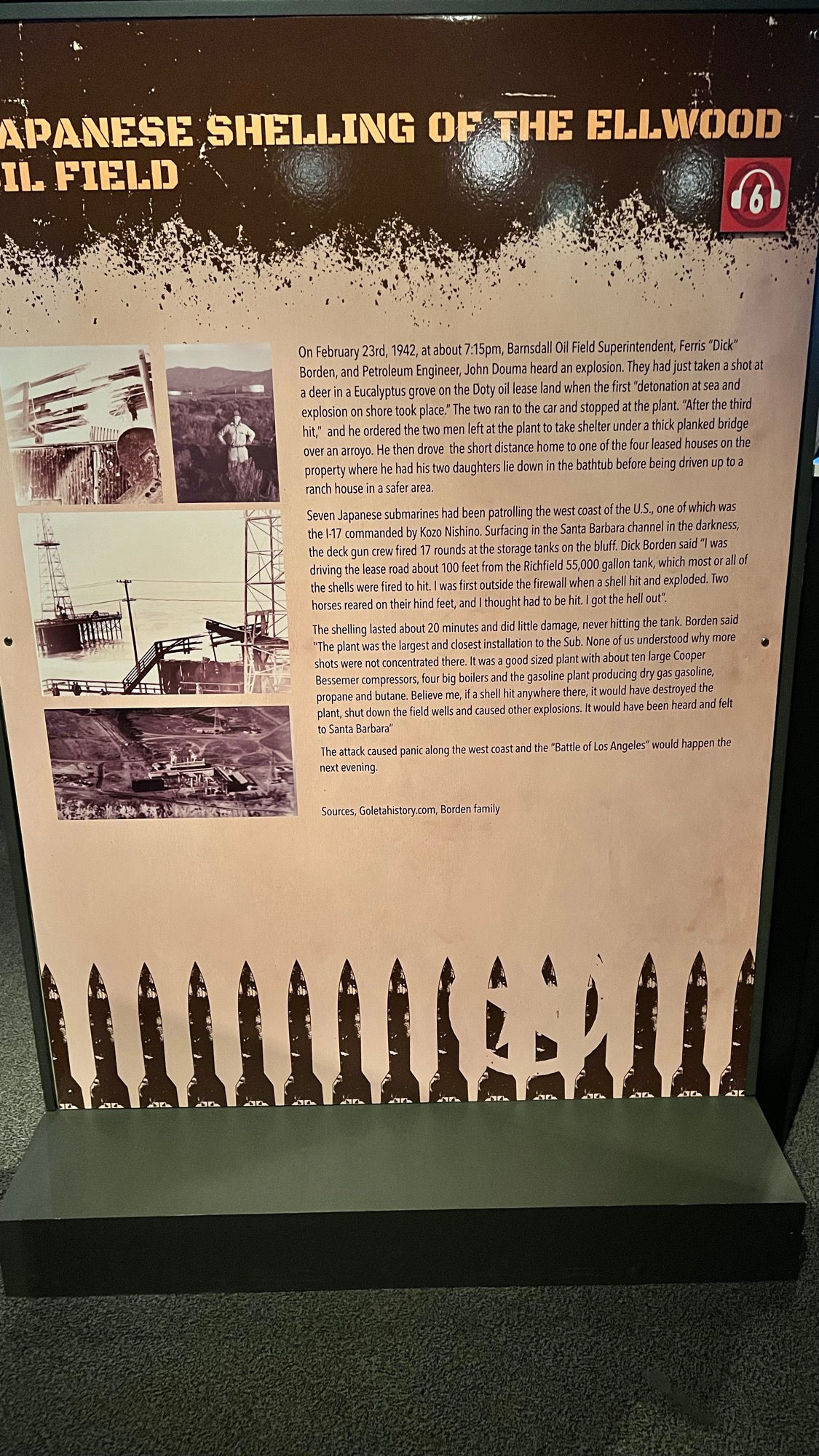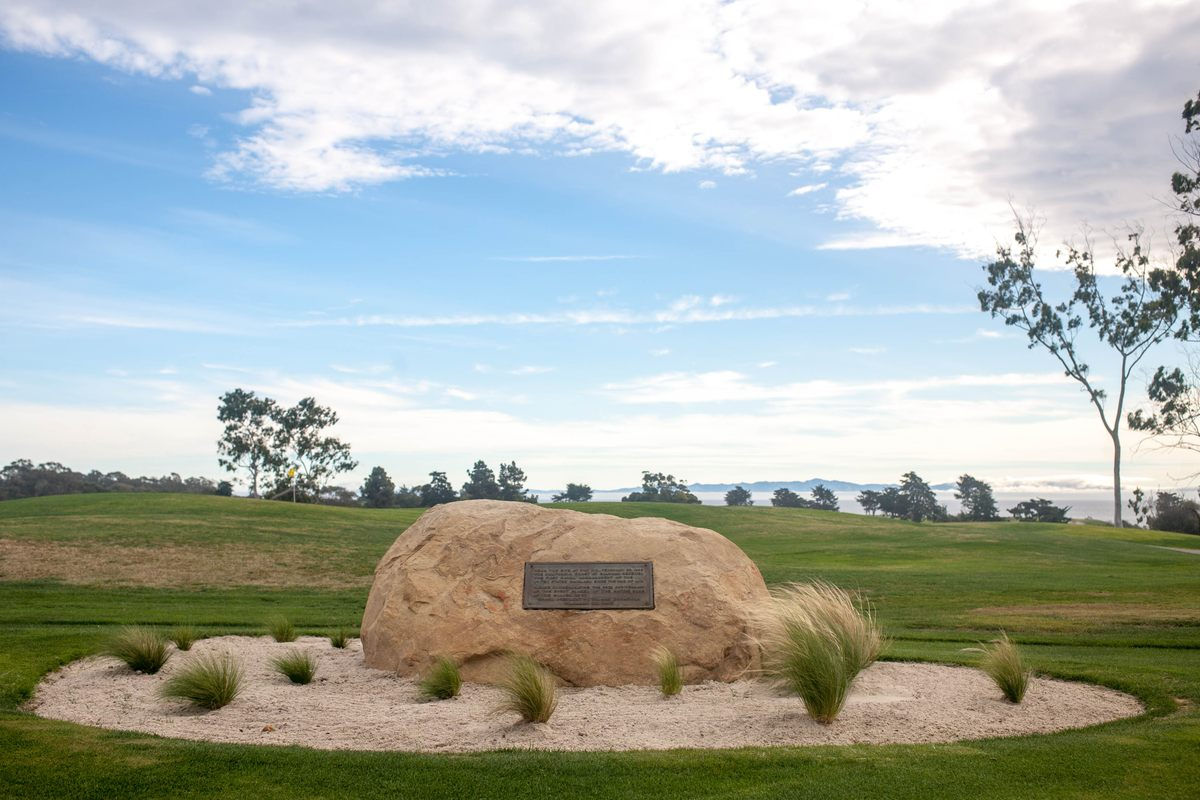February 23rd, 1942: Seven Japanese submarines were patrolling the west coast of the U.S. One surfaced in the Santa Barbara channel in the darkness and the deck gun crew fired 17 rounds at the oil field storage tanks on the bluff. The shelling lasted about 20 minutes but did little damage, never hitting a tank. The attack caused panic along the west coast and the Battle of Los Angeles would happen the next evening. [https://www.eatlife.net/reagan-library/battle-of-los-angeles.php]

On February 23rd, 1942, at about 7:15pm, Barnsdall Oil Field Superintendent, Ferris "Dick" Borden, and Petroleum Engineer, John Douma heard an explosion. They had just taken a shot at a deer in a Eucalyptus grove on the Doty oil lease land when the first "detonation at sea and explosion on shore took place." The two ran to the car and stopped at the plant. "After the third hit," and he ordered the two men left at the plant to take shelter under a thick planked bridge over an arroyo. He then drove the short distance home to one of the four leased houses on the property where he had his two daughters lie down in the bathtub before being driven up to a ranch house in a safer area.
Seven Japanese submarines had been patrolling the west coast of the U.S., one of which was the I-17 commanded by Kozo Nishino. Surfacing in the Santa Barbara channel in the darkness, the deck gun crew fired 17 rounds at the storage tanks on the bluff.
I was driving the lease road about 100 feet from the Richfield 55,000 gallon tank, which most or all of the shells were fired to hit. I was first outside the firewall when a shell hit and exploded. Two horses reared on their hind feet, and I thought had to be hit. I got the hell out.
The shelling lasted about 20 minutes and did little damage, never hitting the tank.
The plant was the largest and closest installation to the Sub. None of us understood why more shots were not concentrated there. It was a good sized plant with about ten large Cooper Bessemer compressors, four big boilers and the gasoline plant producing dry gas gasoline, propane and butane. Believe me, if a shell hit anywhere there, it would have destroyed the plant, shut down the field wells and caused other explosions. It would have been heard and felt to Santa Barbara
The attack caused panic along the west coast and the "Battle of Los Angeles" would happen the next evening.
Sources, Goletahistory.com [ https://goletahistory.com/attack-on-ellwood/ ], Borden family

Fired at Ellwood, Calif
February 23, 1942
Collected by Peter A. Lango
These fragments are from explosives fired at the Elwood oil installations by a Japanese I-17 submarine commanded by Kozo Nishino. They were collected by Peter A. Langlo at Goleta, CA.

WIKIPEDIAI-17
Japanese B1 type submarine of the Imperial Japanese Navy which saw service during World War II. This long-range submarine cruiser spent the early months of the war in the eastern Pacific and was the first Axis ship to shell the continental United States. She later supported the Imperial Japanese Army in fighting around the Solomon Islands and remained active in the southwest Pacific until she was sunk in August 1943.At night on 19 February 1942, I-17 covertly landed on Point Loma, San Diego to determine her position after arriving from Kwajalein Atoll. I-17 then headed north along the coast of California. On 23 February, I-17 achieved some notability as the first Axis ship to shell the United States mainland in an incident known as the Bombardment of Ellwood. A few minutes after 7 pm, she surfaced a few hundred yards off a beach 10 miles (16 km) west of Santa Barbara, California, within the Ellwood Oil Field. Over 20 minutes, she fired 17 shells from her 14 cm gun at the giant Richfield aviation fuel storage tanks on the blufftop behind the beach. The shots were mostly wild, one landing more than a mile inland. The closest shell exploded in a field 30 yards (27 m) from one of the tanks. The shelling did only minor damage to a pier and a pumphouse, but news of the shelling triggered an "invasion" scare along the West Coast.
WIKIPEDIAThe Bombardment of Ellwood
World War II
A naval attack by a Japanese submarine against United States coastal targets near Santa Barbara, California. Though the damage was minimal, the event was key in triggering the West Coast invasion scare and influenced the decision to intern Japanese-Americans. The event also marked the first shelling of the North American mainland during the conflict.Following the surprise attack on Pearl Harbor in Hawaii, seven Japanese submarines patrolled the American West Coast. They sank two merchant ships and damaged six more, skirmishing twice with U.S. Navy air or sea forces. By the end of December, the submarines had all returned to friendly waters to resupply. However, several had gone to Kwajalein and would pay a return visit to American waters. One of these was the Imperial Japanese Navy submarine I-17.
The Japanese government, concerned about President Roosevelt's radio speech scheduled for February 23, 1942, ordered a Japanese submarine to shell the California coast on that day.
At around 7:00 pm on February 23, 1942, the I-17 came to a stop opposite the Ellwood field on the Gaviota Coast. Nishino ordered the deck gun readied for action. Its crew took aim at a Richfield aviation fuel tank just beyond the beach and opened fire about 15 minutes later with the first rounds landing near a storage facility. The oil field's workmen had mostly left for the day, but a skeleton crew on duty heard the rounds hit. They took it to be an internal explosion until one man spotted the I-17 off the coast. An oiler named G. Brown later told reporters that the enemy submarine looked so big to him he thought it must be a cruiser or a destroyer until he realized that only one gun was firing.
Nishino soon ordered his men to aim at the second storage tank. Brown and the others called the police, as the Japanese shells continued to fall around them.
Firing in the dark from a submarine buffeted by waves, it was inevitable that rounds would miss their target. One round passed over Wheeler's Inn, whose owner Laurence Wheeler promptly called the Santa Barbara County Sheriff's Office. A deputy sheriff assured him that warplanes were already on their way, but none arrived. The Japanese shells destroyed a derrick and a pump house, while the Ellwood Pier and a catwalk suffered minor damage. After 20 minutes, the gunners ceased fire and the submarine sailed away. Estimates of the number of explosive shells fired ranged from 12 to 25. Although he caused only light damage, Nishino had achieved his purpose, which was to spread fear along the American west coast. A day later, reports of enemy aircraft led to the so-called "Battle of Los Angeles," in which American artillery was discharged over Los Angeles for several hours due to the mistaken belief that the Japanese were invading.
Reverend Arthur Basham of Montecito called the police to claim he had seen the enemy submarine from his home. He said the I-17 turned south towards Los Angeles, apparently flashing signal lights to someone onshore. In reality, the I-17 had sailed west, safely returning to Japan.
- The attack was the first naval bombardment of the United States by a foreign power since the War of 1812. Additionally, at about 5,100 miles east of Japan, the bombardment of Ellwood was the furthest direct attack on a land target that the Japanese Empire made during World War Two.
- The reports of Nishino's attack caused hundreds to flee inland; many feared that the event was a prelude to a full-scale attack on the West Coast of the United States. Since several people in Santa Barbara claimed to have seen "signal lights", a blackout was ordered for the rest of the night. The claims of signals were used to justify Franklin D. Roosevelt's internment of Japanese Americans, which began just one week later.
- The night after the Elwood attack, the Battle of Los Angeles took place. In response to claimed sightings of "enemy aircraft", anti-aircraft batteries opened fire all across the city, causing panic among its residents.
- Japanese submarines continued to conduct occasional attacks against allied shipping off the U.S. coast during the rest of the war. Sent to American waters in hopes of targeting warships, the submarines managed to sink only a handful of merchant ships, besides conducting a few minor attacks on shore targets. These consisted of a bombardment of Fort Stevens on the Columbia River, an attack on a Canadian lighthouse on Vancouver Island, and two air raids launched from a submarine in an attempt to start forest fires in southwest Oregon.
Monument to the Bombardment of Ellwood
The first attack on the continental U.S. during WWII occurred off the coast of a quiet California golf courseAtlas ObscuraA simple stone marker on a Southern California golf course marks the spot where a Japanese submarine tried to take out an oil field at the beginning of World War II. It didn't succeed, but the attack tragically hastened the government's plan to round up more than 100,000 Japanese-Americans and place them in internment camps.It was a little after 7 p.m. on February 23, 1942, in the small town of Goleta, about 10 miles up the coast from Santa Barbara. Ten-year-old J.J. Hollister and his family had just settled in to listen to President Roosevelt on the radio, when the boy thought he heard thunder. There was a thump, and J.J. and his family ran outside to find bright flashes lighting up the Ellwood Oil Field, just off shore.
A Japanese submarine was shelling Goleta, in the hope of destroying the oil installations. Unlike other oil fields on the California coast, Ellwood had no military protection, making it an easy target. In all, a dozen or two shells landed on Goleta, but little physical damage was done. Instead, the toll of the attack fell on the national psyche, with headlines crying "Submarine Shells Southland Oilfield," and "First Attack of War on Continental U.S."
The panic created by the attack at Ellwood sparked what became known as the "Battle of Los Angeles," when the following night saw a barrage of defensive anti-aircraft fire by the U.S. military, an overreaction to the spotting of an innocent weather balloon.

Today two markers along the Santa Barbara Channel commemorate this rare attack on the continental United States: a stone in the middle of the Sandpiper Golf Course, and a small wooden sign a quarter mile away at Haskell's Beach.








